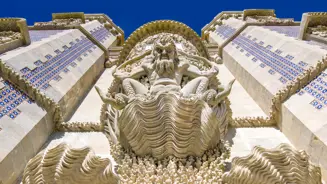Why is there a scary triton in the Palace of Pena?
20 Apr 2023

Those who visit the Palace of Pena are not indifferent to the grotesque figure that's found there. A monster - half man, half fish. Why did King Ferdinand II want to put this triton at the entrance to his palace?
This figure towers over the ‘Coral Gate’, or the tree of waters. The idea would be to play with the dual meaning of the tree, the symbol of life, and of deep waters, which evoke death, but also the origin of the world. There’s an ambivalence with regard to the presence of the roots of the vine born of the triton's hair - “they are a sign of death, but, being represented in plain sight, they, in contradiction, symbolise the life that will grow and assert itself”, explains Mariana Schedel, curator of the Palace of Pena.
According to researcher Regina Anacleto, the merman “evokes the period prior to the formation of the world (…) it’s at the foundation of a re-birth that turns out to be resurrection. “The old man dies, long live the new man”, this is the formula to summarise the symbolism of the monster”.
In her work, the historian adds that this figure ends up functioning as a “guardian of palaces and treasures, not the fabulous ones, belonging to the outside world, but those related to the inner world (…) which can only be reached through subjective and intimate transformation (…)”. Its specific location at the entrance to the Pena Palace thus allows it to ‘confront the gaze’ of those passing by. “Perhaps it calls back to the status of medieval gargoyles, which contemplate those who are still ‘on the outside’ and who still haven't dared to pass through the portal to touch the sacred ground”, suggests Mariana Schedel.
The (legendary) origin of the triton in Sintra
It’s believed that King Ferdinand II was the author of the design for this monster, crafted out of limestone, but where did the king find inspiration to create such a figure? What is its connection to the Palace and Sintra?
One of the aspects is related to the architectural influences of the monument: the connection to the marine world, referring to the “Manueline revival that permeates the entire Palace of Pena”, says the curator. “It’s supporting position is inspired by the Manueline Window at the Convent of Tomar”, she adds.
But the truth is that there could be an influence even older than this, based on the legends of Sintra. Over thousands of years, many stories have emerged about the presence of mythological characters on the region's beaches, where the land ends and the sea begins.
The best known is specifically that of the triton, who lived in 'Fojo Well', close to Adraga Beach. According to Pliny the Elder (27-79 AD), in this area “(…) in a certain cave, a Merman was seen in the form that is well known, playing a conch shell”. “I have testimonies from distinguished members of the equestrian order attesting that they themselves saw a marine man in the ocean of Gades, with all parts of his body resembling a man”, adds the classic author, in his ‘Historiae Naturalis Libri XXXVII’.
Centuries later, more precisely in 1554, when describing Necklaces in the work ‘Urbis Olisiponi Descriptio’, Damião de Góis states that “(…) not far from the village, under a rock overlooking the sea, there is a cave beaten by the ocean. The cave swallows the waves that penetrate inside and collide in a mess of water and foam, before vomiting them out again accompanied by the enormous noise of the waves. Hence our people believe that a Merman was once seen there singing with his shell”. The chronicler doesn’t refute this idea, since “in the Ancient Archives of the Kingdom, of which I myself am (…) in charge, there is still an ancient manuscript of a contract (…), in this document the tax on mermaids and other species of animals caught on the beaches is stated (…). From this it’s obviously deduced that mermaids were frequent in our waters at that time, since a law was enacted about them”. The law would apply not only to mermaids, but also to “Mermen and Nereides”.
Damião de Góis also wrote that, at that time, it was even possible to find along the coast “a kind of men that the inhabitants of the area began to call marine men, due to their nature and origin, above all because they exhibited and retained coarseness or scales on the surface of their skin (…) as if they were vestiges of their ancient race. It has always been taken for granted that such beings owe their origin and ancestry to marine men or Mermen. All of this comes from the traditions of the ancestors that the Mermen sometimes jumped ashore, and gradually got used to playing on the beach; attracted by the sweetness of the fruit, which is very abundant in that region, they returned there frequently; through the ineffable cunning of the inhabitants, some of them were caught and then lovingly initiated into a more civilised and less savage way of life”.
Thus, the presence of the triton in the Palace of Pena can also be seen as an ode to the legends of Sintra, the fantastical beings who, like King Ferdinand, loved this land so much that they decided to stay here.
